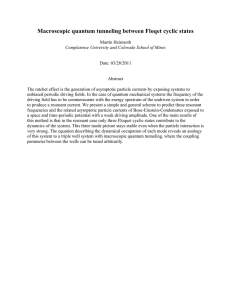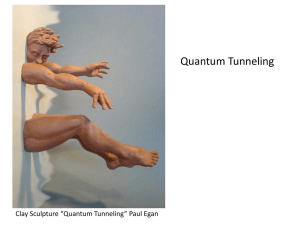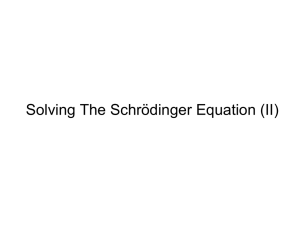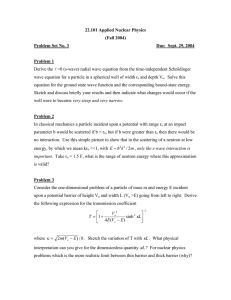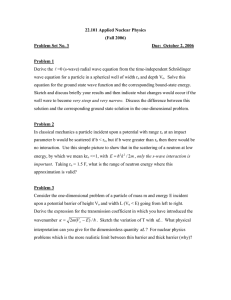Quantum tunneling time
advertisement
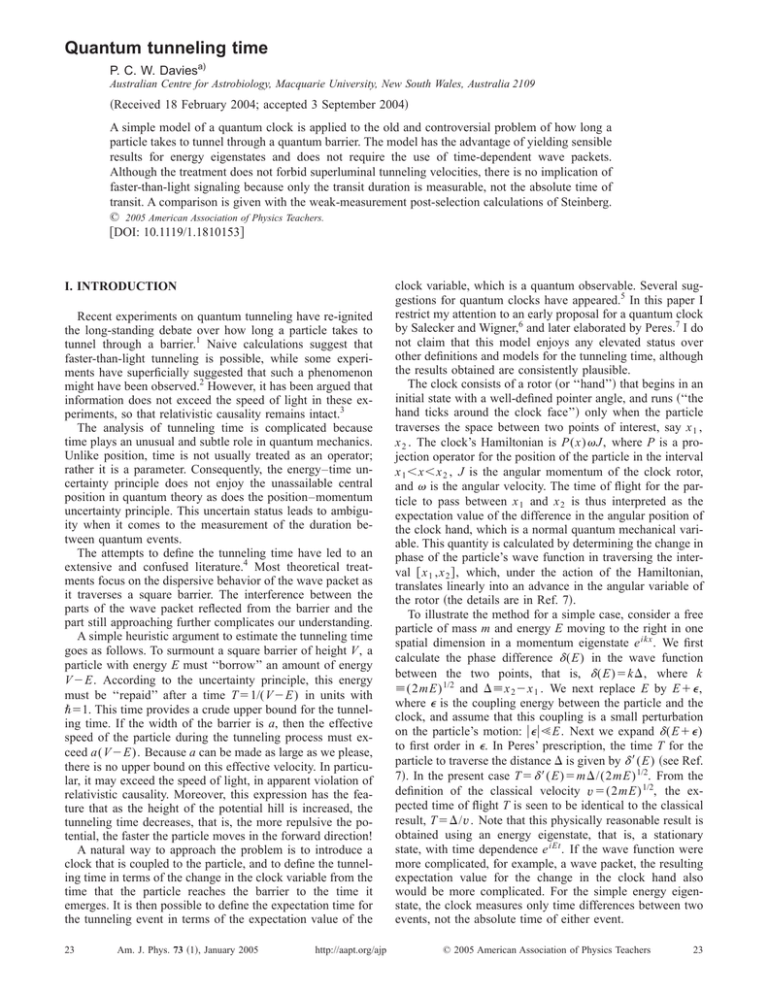
Quantum tunneling time P. C. W. Daviesa) Australian Centre for Astrobiology, Macquarie University, New South Wales, Australia 2109 共Received 18 February 2004; accepted 3 September 2004兲 A simple model of a quantum clock is applied to the old and controversial problem of how long a particle takes to tunnel through a quantum barrier. The model has the advantage of yielding sensible results for energy eigenstates and does not require the use of time-dependent wave packets. Although the treatment does not forbid superluminal tunneling velocities, there is no implication of faster-than-light signaling because only the transit duration is measurable, not the absolute time of transit. A comparison is given with the weak-measurement post-selection calculations of Steinberg. © 2005 American Association of Physics Teachers. 关DOI: 10.1119/1.1810153兴 I. INTRODUCTION Recent experiments on quantum tunneling have re-ignited the long-standing debate over how long a particle takes to tunnel through a barrier.1 Naive calculations suggest that faster-than-light tunneling is possible, while some experiments have superficially suggested that such a phenomenon might have been observed.2 However, it has been argued that information does not exceed the speed of light in these experiments, so that relativistic causality remains intact.3 The analysis of tunneling time is complicated because time plays an unusual and subtle role in quantum mechanics. Unlike position, time is not usually treated as an operator; rather it is a parameter. Consequently, the energy–time uncertainty principle does not enjoy the unassailable central position in quantum theory as does the position–momentum uncertainty principle. This uncertain status leads to ambiguity when it comes to the measurement of the duration between quantum events. The attempts to define the tunneling time have led to an extensive and confused literature.4 Most theoretical treatments focus on the dispersive behavior of the wave packet as it traverses a square barrier. The interference between the parts of the wave packet reflected from the barrier and the part still approaching further complicates our understanding. A simple heuristic argument to estimate the tunneling time goes as follows. To surmount a square barrier of height V, a particle with energy E must ‘‘borrow’’ an amount of energy V⫺E. According to the uncertainty principle, this energy must be ‘‘repaid’’ after a time T⫽1/(V⫺E) in units with ប⫽1. This time provides a crude upper bound for the tunneling time. If the width of the barrier is a, then the effective speed of the particle during the tunneling process must exceed a(V⫺E). Because a can be made as large as we please, there is no upper bound on this effective velocity. In particular, it may exceed the speed of light, in apparent violation of relativistic causality. Moreover, this expression has the feature that as the height of the potential hill is increased, the tunneling time decreases, that is, the more repulsive the potential, the faster the particle moves in the forward direction! A natural way to approach the problem is to introduce a clock that is coupled to the particle, and to define the tunneling time in terms of the change in the clock variable from the time that the particle reaches the barrier to the time it emerges. It is then possible to define the expectation time for the tunneling event in terms of the expectation value of the 23 Am. J. Phys. 73 共1兲, January 2005 http://aapt.org/ajp clock variable, which is a quantum observable. Several suggestions for quantum clocks have appeared.5 In this paper I restrict my attention to an early proposal for a quantum clock by Salecker and Wigner,6 and later elaborated by Peres.7 I do not claim that this model enjoys any elevated status over other definitions and models for the tunneling time, although the results obtained are consistently plausible. The clock consists of a rotor 共or ‘‘hand’’兲 that begins in an initial state with a well-defined pointer angle, and runs 共‘‘the hand ticks around the clock face’’兲 only when the particle traverses the space between two points of interest, say x 1 , x 2 . The clock’s Hamiltonian is P(x) J, where P is a projection operator for the position of the particle in the interval x 1 ⬍x⬍x 2 , J is the angular momentum of the clock rotor, and is the angular velocity. The time of flight for the particle to pass between x 1 and x 2 is thus interpreted as the expectation value of the difference in the angular position of the clock hand, which is a normal quantum mechanical variable. This quantity is calculated by determining the change in phase of the particle’s wave function in traversing the interval 关 x 1 ,x 2 兴 , which, under the action of the Hamiltonian, translates linearly into an advance in the angular variable of the rotor 共the details are in Ref. 7兲. To illustrate the method for a simple case, consider a free particle of mass m and energy E moving to the right in one spatial dimension in a momentum eigenstate e ikx . We first calculate the phase difference ␦ (E) in the wave function between the two points, that is, ␦ (E)⫽k⌬, where k ⬅(2mE) 1/2 and ⌬⬅x 2 ⫺x 1 . We next replace E by E⫹ ⑀ , where ⑀ is the coupling energy between the particle and the clock, and assume that this coupling is a small perturbation on the particle’s motion: 兩 ⑀ 兩 ⰆE. Next we expand ␦ (E⫹ ⑀ ) to first order in ⑀. In Peres’ prescription, the time T for the particle to traverse the distance ⌬ is given by ␦ ⬘ (E) 共see Ref. 7兲. In the present case T⫽ ␦ ⬘ (E)⫽m⌬/(2mE) 1/2. From the definition of the classical velocity v ⫽(2mE) 1/2, the expected time of flight T is seen to be identical to the classical result, T⫽⌬/ v . Note that this physically reasonable result is obtained using an energy eigenstate, that is, a stationary state, with time dependence e iEt . If the wave function were more complicated, for example, a wave packet, the resulting expectation value for the change in the clock hand also would be more complicated. For the simple energy eigenstate, the clock measures only time differences between two events, not the absolute time of either event. © 2005 American Association of Physics Teachers 23 The fact that the clock measures time differences is a key point. Suppose that we try to measure the tunneling time by first measuring the time at which the particle arrives at the leading edge of the potential hill, then measure the time at which it emerges on the other side, and take the difference. The act of observing the particle at the first position collapses the wave function to a position eigenstate and introduces arbitrary uncertainty into the momentum, so that the second measurement is changed. If, on the other hand, we forsake knowing the absolute time of passage of the particle, but require only the time for the particle to pass between two fixed points in space, then only a single measurement 共a measurement of the time difference兲 is required, and there is no large unpredictable disturbance. powers of ⑀ and treat ⑀ as small. This procedure is clearly untrustworthy near both E⫽0 and E⫽V. I shall return to this problem later. We also may calculate the time for the particle to go from x⫽⫺b to x⫽b ⬘ ⬎0 by examining the phase of the wave function in the region x⬎0 关the B-dependent term in Eq. 共1兲兴. If E⬍V, the method suggests an imaginary phase shift ⫺pb ⬘ , implying an imaginary time. If E⬎V, we obtain b/ v ⫹b ⬘ / v ⬘ , where v ⬘ ⫽ 关 2(E⫺V)/m 兴 1/2 is the classical velocity above the step. Evidently we may patch together the time of flight before the step with that at the reduced velocity after the step. III. POTENTIAL HILL II. POTENTIAL STEP As a less elementary example, consider a particle scattering from a potential step of height V situated at x⫽0. The stationary state wave function has space-dependent part e ikx ⫹Ae ⫺ikx Be ⫺px e ikx ⫹Ae ⫺ikx 共 x⬍0 兲 , 共1兲 共 x⬎0 兲 , where p⫽ 关 2m(V⫺E) 兴 . The overall normalization factor does not affect the result and will be omitted. Suppose we require the expectation value for the time of flight of the particle to travel from x⫽⫺b to the barrier and back again. At x⫽⫺b the phase of the incident portion of the wave function is ⫺kb. We use the continuity of the wave function and its first derivative at the step, solve for A, and find for the reflected phase the value kb⫹ ␣ , where 1/2 ␣ ⫽arctan共 Im A/Re A 兲 , 共2兲 A⫽⫺ 共 p⫹ik 兲 / 共 p⫺ik 兲 . 共3兲 and Thus ␦ (E)⫽2kb⫹ ␣ and we find by differentiating with respect to E that T⫽2b/ v ⫹2m/k p⫽2 共 b⫹d 兲 / v , 共4兲 where d⬅1/p is the expectation value for the penetration depth of the particle into the potential step. Equation 共4兲 has an intuitively simple interpretation. The term 2b/ v is the time of flight from x⫽⫺b to the potential step at x⫽0 and back again, at the classical velocity v . The term 2d/ v represents the expectation value of the additional duration of the particle in the classically forbidden region and can be interpreted as if the particle moves with the classical velocity v for a distance d equal to the average penetration depth and back again. Thus the effective distance from x⫽⫺b to the step is increased from the classical distance b to b⫹d. Note that if V→⬁, then d vanishes, so an infinite potential step yields instantaneous reflection. On the other hand, as E→V, p→0 and the time beneath the step diverges; the particle takes an infinite time to bounce back. For E⬎V, p is imaginary, A is real, and ␣⫽0. The roundtrip time therefore reduces to the classical result 2b/ v . The reflection from the step also is instantaneous in this case, even when E→V from above. There would thus appear to be an infinite discontinuity in the reflection time at E⫽V. However, we must be cautious. The method of calculation demands that we expand functions of E⫺ ⑀ and V⫺E⫺ ⑀ in 24 Am. J. Phys., Vol. 73, No. 1, January 2005 I now treat the case of principal interest: a particle that tunnels through a square potential hill given by V ⫽constant⬎0 in the interval 关 0,a 兴 and zero elsewhere. The wave function is Be ⫹Ce px De ikx 共 x⬍0 兲 , ⫺px 共5兲 共 0⬍x⬍a 兲 , 共 x⬎a 兲 . We use continuity of the wave function and its derivative at x⫽0 and x⫽a, and find the phase change to be ␦ 共 E 兲 ⫽arctan兵 关 p 2 ⫺k 2 兲 /2kp 兴 tanh共 pa 兲 其 . 共6兲 If we differentiate ␦ (E) with respect to E, we find the expectation value of the tunneling time: T⫽2m 兵 k 共 p 2 ⫺k 2 兲 a⫹ 关共 p 2 ⫹k 2 兲 2 /2kp 兴 ⫻sinh 2pa 其 / 关共 p 2 ⫹k 2 兲 2 cosh2 pa⫺ 共 p 2 ⫺k 2 兲 2 兴 . 共7兲 As a check, we note that when V⫽0, p⫽ik and T⫽ma/k ⫽a/ v as expected. In the special case E⫽V/2, the right-hand side of Eq. 共7兲 reduces to tanh(ka)/E. For small a, it approaches (ma/2k)(3⫹ p 2 /k 2 ), which goes to zero as a→0, as expected. If we define the effective velocity of the particle to be v eff⬅a/T, then for small a v eff⬇2 v / 共 2⫹V/E 兲 , 共8兲 where v is the classical velocity of the particle outside the potential hill. Note that v eff⬍v in this limit: thin potential hills slow the particle down, as occurs classically. For E ⫽V/2, v eff⫽v/2. For VⰇE, the limit used in Eq. 共7兲 breaks down. Of interest is a delta-function potential hill, where Va 2 ⫽constant as V→⬁ and a→0. If we return to Eq. 共7兲 and apply these limits, we find that T→0. There is no problem here about reflected waves slowing the particle as it approaches the barrier. This result is consistent with the work of Aharonov, Erez, and Reznik,8 who find T⫽0 for the tunneling time through an array of delta function potential hills. In contrast to the slowing effect, thick hills serve to speed the particle up, that is, v eff⬎v. If we take the limit a→⬁ in Eq. 共7兲, we see that the tunneling time approaches the constant value 2m/kp⫽ 关 E 共 V⫺E 兲兴 ⫺1/2. 共9兲 Equation 共9兲 is similar to the result found from the naive argument mentioned in Sec. I. The right-hand side of Eq. 共9兲 P. C. W. Davies 24 is reminiscent of the energy that can be ‘‘borrowed’’ for a time T according to Heisenberg’s uncertainty principle, but with the interesting difference that the borrowing requirement is not simply V⫺E, but the harmonic mean of this quantity and E. The tunneling time is minimized for E ⫽V/2, and in this case T⫽1/E. Note that Eq. 共9兲 also is equal to the second term on the right-hand side of Eq. 共4兲, the sojourn time inside a potential step. We shall see that this equality is a special limit of the general result that the expectation time for a particle to reflect back from the potential barrier is the same as the expectation time for it to penetrate the barrier. The effective velocity under the barrier is v eff⫽aE 1/2共 V⫺E 兲 1/2, 共10兲 which increases without limit as a→⬁. In particular, v eff exceeds the speed of light c when pa⬎2mc/k ⫽2 共 de Broglie wavelength兲/共Compton wavelength兲 . 共11兲 However, for thick barriers the transmission probability is very small. To estimate it, first note that if the approaching particle is to remain nonrelativistic 共as assumed in the treatment given here兲, then the right-hand side of Eq. 共11兲 must be much greater than unity, which implies that paⰇ1. In this limit the transmission probability reduces to 16共 E/V 2 兲共 V⫺E 兲 e ⫺2pa . 共12兲 2 Consider, for example, the case E⫽V/2⫽mc /8. If we take pa⫽2mc/k 共corresponding to the onset of superluminal propagation兲, the barrier penetration probability is then 4e ⫺8 ⬇10⫺3 . Although small, this probability is by no means negligible, and we have to confront the consequences for causality if it is indeed the case that the occasional particle can tunnel faster than light. A violation of causality would arise if observer A could send information to an observer B a distance d away, such that it arrives before a time d/c has elapsed. Could A use an electron to encode this information, and arrange for it to tunnel through a barrier to B in the knowledge that, albeit only occasionally, B will receive the electron before a time d/c? To achieve physical causality violation, A must be able to determine the moment of transmission of the information. But as we have seen, the model discussed here can determine only the time difference between the moment of ‘‘transmission’’ and ‘‘reception’’ of the particle—not the absolute time of transmission. If d/c⫺T⫽⌬t, then to be causally relevant, the signaling process must be controlled to an accuracy less than ⌬t; however, this control is not possible in the model using energy eigenstates. Any faster than light propagation would therefore be fortuitous—entirely random and uncontrollable. Tunneling may violate the spirit of relativity, but it does not violate the letter. A more systematic treatment of this issue would be worthwhile, extending the analysis to more complicated states, such as wave packets and other superpositions. The foregoing calculation is a poor guide to a more ambitious calculation, because the sum of the phases of the components of a wave function is generally different from the phase of the sum. We cannot therefore superpose the transit time results of energy eigenstates to obtain the results for a wave packet. 25 Am. J. Phys., Vol. 73, No. 1, January 2005 A related open question is the relation between the present quantum tunneling time analysis and the apparently superluminal propagation of wave pulses reported in classical optics, mentioned briefly in Sec. I.2 Under certain exotic conditions, it can appear as if a pulse of light exits a medium ahead of the light-travel time from the point of entry. A careful analysis, however, reveals that this phenomenon cannot be used to transmit information faster than light.3 The appearance of superluminality can be traced to a change in the shape of the pulse. It would be interesting to apply the Peres clock analysis to such a scenario. IV. MEASUREMENT UNCERTAINTY The model clock used here is a quantum system, and is therefore subject to quantum uncertainty in its operation, which in turn implies an uncertainty in the calculated tunneling time. As shown by Peres,7 the back action of the clock’s dynamics on the particle’s motion, which persists throughout the experiment, will limit the resolution of the model clock. In particular, it is unreliable when E→0 or E→V. The resolution of the clock is limited by the assumption that 兩 E 兩 and 兩 V⫺E 兩 are Ⰷ⑀. The energy–time uncertainty relation applied to the clock variables then suggests that the clock pointer will have an uncertainty corresponding to a time ⬇1/⑀ Ⰷ1/E. But the tunneling time as illustrated by the asymptotic value in Eq. 共9兲 is itself of order 1/E. Hence the quantum uncertainty in measuring the tunneling time T is at least the same order as the expectation value of the tunneling time. This result is no surprise, because any limitation in the measurement resolution will have this general form on dimensional grounds. The disturbance on the particle’s motion caused by the back action can be reduced by making the coupling weaker, but at the expense of introducing greater uncertainty in the measurement of the clock reading. An alternative strategy for reducing the uncertainty is to use a clock that is not continuously coupled to the particle. One way to achieve such a reduction would be to place the clock in a metastable state, and then using the arrival of the particle at the leading edge of the barrier to merely trigger the operation of the clock via a momentary interaction. This sort of device has been studied by Oppenheim, Reznik, and Unruh.9 Surprisingly, it does not result in a reduction in the overall uncertainty. The reason is that the sharply localized potential associated with the triggering device reflects some of the wave function, and attempts to mitigate this back-action effect 共for example, by boosting the energy of the particle just before the barrier兲 serves only to introduce additional uncertainties. Thus there seems to be an irreducible uncertainty in the measurement of the tunneling time that is comparable to the tunneling time itself. At first sight this uncertainty appears to cast doubt on the usefulness of the foregoing results. However, as shown by Aharonov et al.,10 by performing measurements on a large ensemble of identical systems, the spread in results can be drastically narrowed, even in cases where the uncertainty for a single measurement exceeds the expected value. Their analysis is known as the theory of weak measurement. If we apply weak measurement theory to the problem of the Peres clock and tunneling time, the implication is that, interpreted as an average over a large ensemble, the results of the foregoing sections are physically meaningful in spite of the intrinsic uncertainty in the operation of the clock. P. C. W. Davies 25 Weak measurement theory often is combined with postselection, whereby a final sub-ensemble is extracted corresponding to the state of interest. In the case of tunneling, this sub-ensemble will include only those particles that penetrate the barrier and move to the right. Steinberg11 has calculated the tunneling time using this approach and has evaluated an expectation value for a projection operator corresponding to the time the particle is inside the barrier in the limit that the measuring device interacts weakly with the particle. The resulting expression is complex. Its real part corresponds to the expectation value of the tunneling time; the imaginary part corresponds to the back action of the measuring device on the particle. These respective parts are related in a transparent manner to other proposed definitions of the tunneling time. For example, the real part is identical to the dwell time,12 which is defined as the probability of finding the particle inside the barrier divided by the incoming flux. Steinberg’s result for the tunneling time expectation value is11 T s ⫽2m 兵 k 共 p 2 ⫺k 2 兲 a⫹ 关 k 共 p 2 ⫹k 2 兲 /2p 兴 ⫻sinh 2pa 其 / 关共 p 2 ⫹k 2 兲 2 cosh2 pa⫺ 共 p 2 ⫺k 2 兲 2 兴 , 共13兲 which should be compared to Eq. 共7兲. The two durations are very similar, but not identical. We find T/T s ⫽V/E⫹ 共 1⫺V/E 兲 / 关 1⫹ 共 V sinh 2pa 兲 /2 ⫻ 共 V⫺2E 兲 pa 兴 . 共14兲 In the free-particle limit V→0, T→T s . In general T s ⬍T for E⬍V. In the limit of large barrier width a, T s → 共 E/V 兲 T⫽ 共 E/V 兲关 E 共 E⫺V 兲兴 1/2. 共15兲 Note that both T and T s diverge as E→V, but the behavior in the limit E→0 is very different, that is, T→⬁, and T s →0. The latter result implies that, as the approach velocity of the particle decreases, the tunneling velocity increases; in the limit v →0, the post-selected tunneling velocity diverges. V. OTHER RESULTS We may use the Peres clock model to calculate other transit times of interest. Consider, for example, the time between incidence and reflection from the leading face of the hill at x⫽0. This time may be calculated by examining the phase of A in Eq. 共5兲. We find for the phase change ␦ 共 E 兲 ⫽arccot兵 关 p 2 ⫺k 2 兲 /2k p 兴 tanh共 pa 兲 其 . 共16兲 But the derivative of Eq. 共16兲 is identical to that of Eq. 共6兲, so the sojourn time inside the hill is the same, whether the particles are transmitted or reflected. Thus the tunneling times for both transmission and reflection are the same. It has been argued4 that the tunneling times for transmission and reflection should satisfy the relation T D⫽ P tT t⫹ P rT r , 共17兲 where T D is the dwell time, P t ( P r ) the probability of transmission 共reflection兲, and T t (T r ) the corresponding tunneling times. Equation 共17兲 is satisfied, for example, by Steinberg’s definition, but not by the one used in this paper. However, Landauer and Martin1 have argued strongly against Eq. 共17兲 as an appropriate criterion. 26 Am. J. Phys., Vol. 73, No. 1, January 2005 Our analysis also may be used to derive results for onedimensional scattering, by putting E⬎V. If we define  ⬅ 关 2m(E⫺V) 兴 1/2, Eq. 共7兲 becomes T⫽2m 兵 k 共 k 2 ⫹  2 兲 a⫹ 关共 k 2 ⫺  2 兲 2 /2k  兴 ⫻sin 2  a 其 / 关共 k 2 ⫺  2 兲 2 cos2  a⫺ 共 k 2 ⫹  2 兲 2 兴 . 共18兲 For small a the right-hand side of Eq. 共18兲 reduces to (ma/2k)(3⫺  2 /k 2 ) with a corresponding effective velocity given by Eq. 共8兲. Again, v eff⬍v, although v eff ⬎关2m(E⫺V)兴1/2, the classical velocity over the barrier. So although the repulsive potential slows the particle, it does not do so as much as in the classical case. Now consider the opposite limit of large a. The denominator on the right-hand side of Eq. 共18兲 can never vanish, and the sine function in the numerator is bounded by 关⫺1,1兴. Thus T⬇2mka/ 共 k 2 ⫹  2 兲 ⫽ka/ 共 2E⫺V 兲 . 共19兲 In contrast to the result for the tunneling case, the right-hand side of Eq. 共19兲 is proportional to a even for large a. The effective velocity (2E⫺V)/k therefore always remains less than c when the particle passes over the barrier: only tunneling events lead to apparent superluminal velocities. For large E, v eff→v, but for particles that just clear the barrier, E ⬇V, v eff⬇v/2. Of special interest is the case of resonance transmission, when  a⫽n , and P t ⫽1. Then Eq. 共18兲 simplifies to T⫽ma 共 k 2 ⫹  2 兲 /2k  2 , 共20兲 v eff⫽ v共 E⫺V 兲 / 共 E⫺V/2兲 . 共21兲 In this case v eff approaches 0 as E→V, as it would classically. The effective velocity, however, has a very different energy dependence from the classical expression. For the case of anti-resonance, where cos(a)⫽0, Eq. 共19兲 becomes exact, and v eff⫽ 共 v ⫹ v ⬘ 兲 /2, 共22兲 which is the average of the classical velocities outside and over the barrier. Note that because the reflection and transmission expectation times are equal, there is always a reflection delay, or sojourn in the region x⬎0, even in the case that E⬎V. This behavior is in contrast to the single potential step, where reflection is instantaneous if E⬎V. The difference has a natural interpretation. For the potential hill, reflection can take place from both the leading and remote faces of the hill. The actual reflections may be instantaneous, but if the particle reflects from the far edge x⫽a, there will be a delay due to the travel time across the top of the hill. The expectation value will therefore include this delay, and the result is consistent with one half the flux being reflected from each edge. VI. CONCLUSION AND SUGGESTIONS FOR FURTHER WORK I have shown by use of a simple model of a quantum clock that sensible and consistent expressions may be derived for the expectation value of the time for a nonrelativistic particle in an energy and momentum eigenstate to pass between two points, as long as the absolute time of passage is not required. The points may be separated by regions that include P. C. W. Davies 26 a variety of potentials, including a square potential barrier. In the latter case the tunneling time is given by an expression that approaches a constant for thick barriers, implying an issue concerning superluminal propagation. However, I have argued that physical causality is not violated. The discussion has been restricted to simple square barriers. It would of interest to consider other types of barriers. The present results may readily be extended to a potential well by putting V⬍0 in the foregoing treatment, and examined for resonant scattering, which occurs when there is a bound energy level just below the top of the well. An intriguing problem is the case of a double square barrier separated by a gap. There have been claims that the traversal time is independent of the gap between the barriers, implying superluminal propagation.13 A calculation of the Peres clock time for this problem would be straightforward and illuminating. The present technique for calculating traversal times need not be limited to square barriers, although exactly solvable cases are difficult to find. A good example for a student project is the potential V(x)⫽(1/2)V 0 关 1⫹tanh(␣x)兴, where V 0 and ␣ are constants. The results should reduce to those of the potential step given in Sec. II when ␣→⬁. Another important example is the uniform gravitational potential V(x) ⫽mgx, which I have discussed in detail elsewhere.14 ACKNOWLEDGMENT I am grateful to Aephraim Steinberg for helpful comments. a兲 Electronic mail: pdavies@els.mq.edu.au For a review, see R. Landauer and Th. Martin, ‘‘Barrier interaction time in tunneling,’’ Rev. Mod. Phys. 66, 217–228 共1994兲. 1 2 A. M. Steinberg, P. G. Kwiat, and R. Y. Chiao, ‘‘Measurement of the single photon tunneling time,’’ Phys. Rev. Lett. 71, 708 –711 共1993兲; R. Y. Chiao, P. G. Kwiat, and A. M. Steinberg, ‘‘Faster than light?,’’ Sci. Am. 52共8兲, 269–275 共1993兲; A. Ranfagni, P. Fabeni, G. P. Pazzi, and D. Mugnai, ‘‘Anomalous pulse delay in microwave propagation: A possible connection to tunneling time,’’ Phys. Rev. E 48, 1453–1460 共1993兲. 3 A. M. Steinberg, ‘‘Clear message for causality,’’ Phys. World 16共12兲, 19–20 共2003兲. 4 E. H. Hauge and J. A. Støvneng, ‘‘The tunneling time for a wave packet as measured with a physical clock,’’ Rev. Mod. Phys. 61, 917–936 共1989兲. 5 See, for example, J. P. Falck and E. H. Hauge, ‘‘Larmor clock reexamined,’’ Phys. Rev. B 38, 3287–3297 共1988兲. 6 H. Salecker and E. P. Wigner, ‘‘Quantum limitations of the measurement of space-time distances,’’ Phys. Rev. 109, 571–577 共1958兲. 7 A. Peres, ‘‘Measurement of time by quantum clocks,’’ Am. J. Phys. 48, 552–557 共1980兲. 8 Y. Aharonov, N. Erez, and B. Reznik, ‘‘Superoscillations and tunneling times,’’ Phys. Rev. A 65, 052124-1–5 共2002兲. 9 J. Oppenheim, B. Reznik, and W. G. Unruh, ‘‘Time as an observable,’’ in Proceedings of the 10th Max Born Symposium, edited by Ph. Blanchard and A. Jadczyk 共Springer-Verlag, Berlin, 1997兲. 10 Y. Aharonov, D. Z. Albert, and L. Vaidman, ‘‘How the result of a measurement of a component of a spin 1/2 particle can turn out to be 100,’’ Phys. Rev. Lett. 60, 1351–1354 共1988兲; Y. Aharonov and L. Vaidman, ‘‘Properties of a quantum system during the time interval between two measurements,’’ Phys. Rev. A 41, 11–20 共1990兲. 11 A. M. Steinberg, ‘‘How much time does a tunneling particle spend in the barrier region?,’’ Phys. Rev. Lett. 74, 2405–2409 共1995兲. 12 M. Buttinger, ‘‘Larmor precession and the traversal time for tunneling,’’ Phys. Rev. B 27, 6178 – 6188 共1983兲. 13 V. S. Olkhovsky, E. Recami, and G. Salesi, ‘‘Tunneling through two successive barriers and the Hartman 共superluminal兲 effect,’’ Europhys. Lett. 57, 879– 884 共2002兲. 14 P. C. W. Davies, ‘‘Quantum mechanics and the equivalence principle,’’ Class. Quantum Grav. 21, 2761–2772 共2004兲. ACTION AT A DISTANCE But the mechanical philosophy already has rules, and Newton was flouting one of them in spectacular fashion. Physical causes were supposed to be direct: matter striking or pressing on matter, not emitting invisible forces to act from afar. Action at a distance, across the void, smacked of magic. Occult explanations were supposed to be forbidden. In eliminating Descartes’s vortices he had pulled away a much-needed crutch. He had nothing mechanical to offer instead. James Gleick, Isaac Newton 共Vintage Books, 2003兲, p. 139. 27 Am. J. Phys., Vol. 73, No. 1, January 2005 P. C. W. Davies 27
